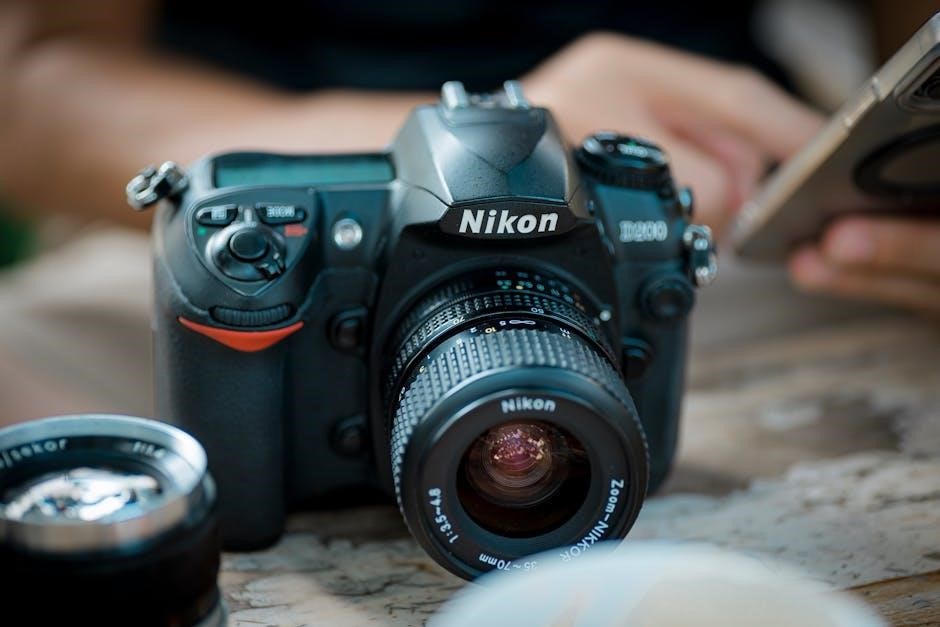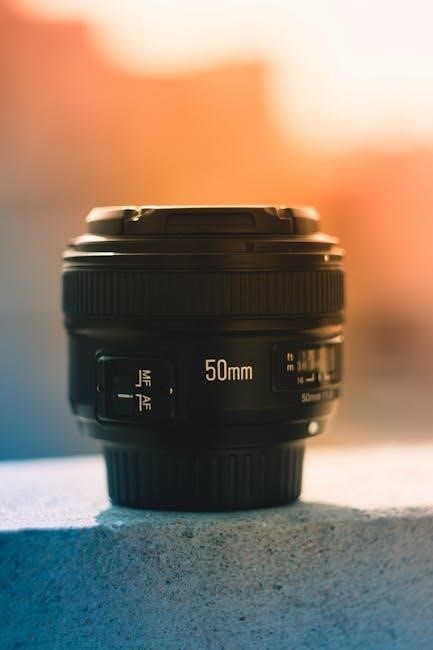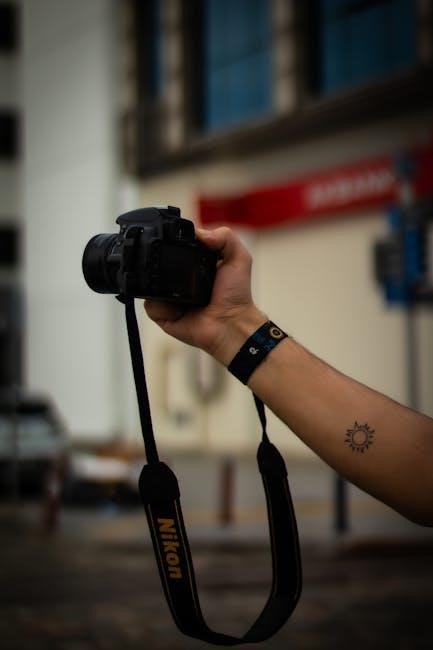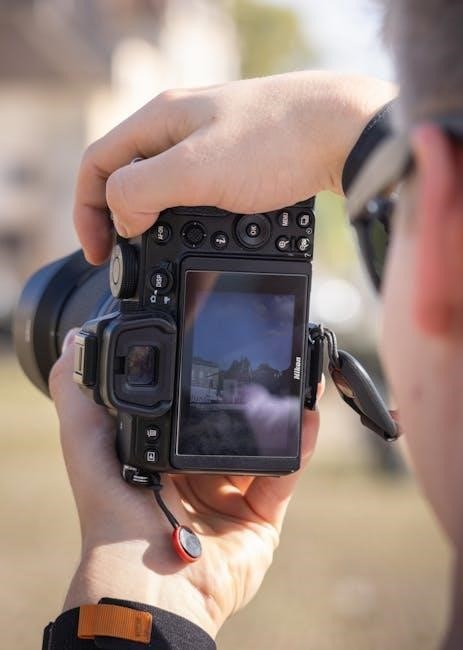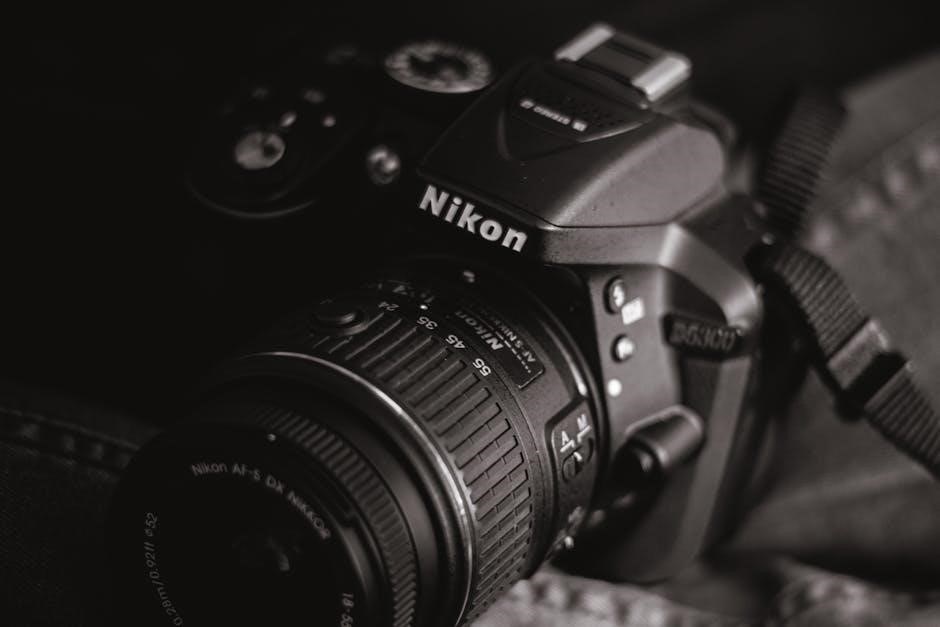The Santa Fe TV Guide is a comprehensive resource for local television listings, offering a glimpse into the city’s vibrant cultural and artistic scene.
It provides detailed information about channels, programs, and events, making it an essential tool for both residents and visitors to stay entertained and informed.
1.1 Overview of Santa Fe’s Television Scene
Santa Fe’s television scene is a diverse blend of local and national programming, catering to a wide range of interests and cultural preferences. The city offers access to major broadcast networks, including ABC, CBS, NBC, and FOX, alongside local affiliates that provide community-focused content. Viewers can enjoy a mix of news, entertainment, sports, and cultural programming, reflecting Santa Fe’s rich artistic and historical heritage. The presence of PBS affiliates and community access channels further enhances the variety, ensuring there’s something for everyone. This vibrant television landscape makes Santa Fe a unique destination for viewers seeking both regional and global perspectives.
1.2 Purpose of the TV Guide
The Santa Fe TV Guide serves as a vital resource for viewers, providing a centralized platform to explore local and national programming.
Its purpose is to simplify the process of discovering shows, movies, and events, ensuring audiences never miss out on their favorite content or new cultural experiences.
By offering detailed listings and schedules, the guide empowers users to make informed viewing choices, tailored to their interests and preferences in Santa Fe’s diverse media landscape.

Major Broadcast Networks in Santa Fe
Santa Fe offers access to major broadcast networks like ABC, CBS, NBC, and FOX, providing a wide range of programming.
These networks deliver news, dramas, sports, and more, catering to diverse viewer preferences and ensuring quality entertainment for the community.
2.1 ABC Affiliates in Santa Fe
Santa Fe’s ABC affiliate, KOAT, is a trusted source for local news, weather, and sports, serving northern New Mexico. It broadcasts a mix of ABC network programming, including popular shows like Grey’s Anatomy and Good Morning America, alongside local content. KOAT provides extensive coverage of regional events, ensuring viewers stay informed about community matters. With a strong commitment to journalism, the station offers in-depth reporting on issues affecting Santa Fe and its surroundings. Whether it’s breaking news or entertainment, KOAT delivers reliable and engaging content to its audience. Its programming schedule is tailored to meet the diverse interests of the local population.
2.2 CBS Affiliates in Santa Fe
In Santa Fe, CBS programming is primarily offered through KRQE, a prominent affiliate serving the region. This channel provides a mix of local news, weather updates, and community-focused content, alongside CBS’s national lineup. Viewers can enjoy popular shows like dramas, comedies, and reality TV, as well as sports events and breaking news. KRQE is a trusted source for both entertainment and information, catering to a wide audience. Its strong signal coverage ensures accessibility across Santa Fe and surrounding areas, making it a key channel for those seeking CBS content in the region.
2.3 NBC Affiliates in Santa Fe
KOB, channel 4, is the primary NBC affiliate serving Santa Fe, offering a mix of local news, weather, and sports, alongside NBC’s primetime lineup. Known for its commitment to community coverage, KOB provides updates on regional events and issues. Viewers can enjoy popular NBC shows like The Voice and Sunday Night Football, as well as local programming tailored to New Mexico’s diverse population. The station also partners with local organizations to highlight community stories and initiatives, making it a trusted source for both entertainment and information in Santa Fe.
2.4 FOX Affiliates in Santa Fe
Santa Fe’s FOX affiliates provide a diverse lineup of programming, including local news, sports, and popular network shows. KASA-TV, a prominent FOX affiliate, broadcasts a mix of entertainment, such as “The Simpsons” and “Family Guy,” alongside local news segments tailored to the Santa Fe community. Viewers can also enjoy live sports events, including NFL games and MLB coverage. These affiliates ensure residents stay connected to both national and regional content, making FOX a key part of Santa Fe’s television offerings. Their programming caters to a wide audience, blending humor, drama, and community-focused content.

Local Channels and Programming
Santa Fe’s local channels offer diverse programming, including community shows, cultural content, and regional news, reflecting the city’s unique heritage and artistic spirit.

From educational programs to local entertainment, these channels provide a platform for Santa Fe’s vibrant community, ensuring a wide range of engaging content for all audiences.

3.1 KNME (PBS Affiliate)
KNME, the PBS affiliate in Santa Fe, offers a diverse range of educational, cultural, and entertaining programming. As part of the New Mexico PBS network, it provides high-quality shows such as Nature, NOVA, and Masterpiece. The channel is known for its commitment to education, featuring children’s programs like Sesame Street and Wild Kratts. KNME also airs local productions that highlight New Mexico’s history, arts, and community stories. With a focus on enriching viewers’ lives, KNME serves as a trusted source for family-friendly and intellectually stimulating content, aligning with PBS’s mission to inform, inspire, and engage audiences.
3.2 KASA (FOX Affiliate)
KASA, a FOX affiliate, brings a diverse lineup of programming to Santa Fe viewers. It features popular FOX shows, local news, and sports, catering to a wide audience. The channel also broadcasts
live events, including NFL games and entertainment series. KASA’s programming reflects Santa Fe’s cultural richness, offering a mix of national and local content. Viewers can enjoy
prime-time hits, reality TV, and syndicated favorites. Additionally, KASA supports community engagement by airing local events and public affairs programs, making it a vital part of Santa Fe’s
television landscape. Its blend of entertainment and local relevance ensures KASA remains a popular choice for residents seeking both national and regional content.
3.3 Local News Channels
Santa Fe’s local news channels provide up-to-date coverage of regional events, weather, and community stories. Channels like KOAT (ABC affiliate) and KRQE (CBS affiliate) are popular for their focus on local issues, ensuring residents stay informed about what matters most. These channels often feature segments on city government, education, and cultural events, making them indispensable for staying connected to the community. With a strong emphasis on accuracy and relevance, Santa Fe’s local news channels are a trusted source for breaking news and in-depth reporting.
3.4 Community Access Channels
Community Access Channels in Santa Fe provide a platform for local voices and perspectives, fostering engagement and inclusivity. These channels air a variety of programs produced by residents, including public access shows, educational content, and government proceedings.
Viewers can enjoy local talk shows, cultural discussions, and coverage of community events. These channels empower individuals and organizations to share their stories, promoting a sense of connection and pride in Santa Fe’s diverse community.

Cultural and Artistic Programming
Santa Fe’s cultural and artistic programming showcases the city’s rich heritage through diverse TV shows, highlighting local arts, traditions, and creative voices.
From gallery tours to live music performances, these programs celebrate Santa Fe’s vibrant cultural identity and inspire viewers to explore its artistic treasures.
4.1 Santa Fe Arts and Culture Shows
Santa Fe’s arts and culture shows showcase the city’s vibrant creative scene, featuring local artists, galleries, and performances. These programs highlight the region’s rich cultural heritage, including visual arts, theater, and music. Viewers can explore the work of renowned and emerging artists, with many shows offering behind-the-scenes looks at artistic processes. The programming often reflects Santa Fe’s diverse influences, blending Native American, Hispanic, and contemporary traditions. From festivals to exhibitions, these shows provide a unique window into the city’s thriving arts community, making them a must-watch for cultural enthusiasts and locals alike.
4.2 Local Theater and Music Performances
Santa Fe’s thriving arts scene is showcased through local theater and music performances, often featured on TV. The city is home to renowned venues like the Santa Fe Opera and the Lensic Performing Arts Center, which host world-class productions. From classical symphonies to contemporary plays, these events are frequently broadcast, allowing viewers to experience the city’s cultural richness from home. Music performances range from traditional New Mexican folk to modern genres, reflecting the diverse heritage of the region. Theater productions often highlight local talent and storytelling, making them a must-watch for audiences. These broadcasts provide a unique opportunity to connect with Santa Fe’s vibrant artistic community.
4.3 Hispanic and Native American Programming
Santa Fe’s TV guide highlights a rich array of Hispanic and Native American programming, showcasing the city’s diverse cultural heritage. These programs feature traditional music, dance, and art, offering insights into the region’s history and traditions. Local channels often broadcast bilingual content, catering to both Spanish and English-speaking audiences.
Native American programming includes documentaries on tribal history, language preservation efforts, and contemporary issues affecting indigenous communities. Hispanic-focused shows celebrate festivals, cuisine, and the contributions of Latino culture to Santa Fe’s identity.
This programming not only entertains but also educates, fostering cultural understanding and appreciation for the city’s vibrant multicultural landscape.

Sports on Santa Fe TV
Santa Fe TV offers a diverse range of sports programming, from local high school games to national leagues and outdoor adventures, ensuring sports enthusiasts stay connected.
5.1 Local Sports Teams and Events
Santa Fe’s sports scene is vibrant, featuring local teams like the Santa Fe Fuego (baseball) and Santa Fe FC (soccer), which draw passionate crowds. The city also hosts high school sports, including football and basketball games, often broadcast on local channels. Community events such as charity sports tournaments and youth leagues are also highlighted, showcasing grassroots talent. The TV guide provides schedules for these events, allowing fans to catch live coverage or replays. Additionally, it features pre-game shows, interviews with local athletes, and analysis of regional competitions. This makes it a valuable resource for staying connected to Santa Fe’s dynamic sports culture.
5.2 National Sports Coverage
Santa Fe’s TV guide offers extensive coverage of major national sports leagues, ensuring fans stay connected to their favorite teams and events. From NFL football to NBA basketball, MLB baseball, and NHL hockey, viewers can catch live games and highlights. Key events like the Super Bowl, World Series, and March Madness are prominently featured. Additionally, sports networks such as ESPN, FOX Sports, and NBC Sports provide in-depth analysis, pre-game shows, and post-game recaps. This comprehensive coverage caters to a wide range of sports enthusiasts, making it easy to follow national sports from the comfort of home in Santa Fe.
5.3 Outdoor and Adventure Sports
Santa Fe’s TV Guide highlights an array of outdoor and adventure sports programming, catering to enthusiasts of nature and thrill-seeking activities.
- Popular shows feature hiking in the Sangre de Cristo Mountains, mountain biking trails, and skiing at nearby resorts like Ski Santa Fe;
- Local channels often broadcast documentaries on rafting, kayaking, and fishing in New Mexico’s rivers and lakes.
- National networks cover extreme sports events, such as rock climbing competitions and endurance races held in the high desert landscapes.
- Some programs focus on Indigenous outdoor traditions, blending cultural insights with adventurous pursuits.
This programming brings the beauty and adrenaline of Santa Fe’s outdoor lifestyle directly to viewers’ screens.

Special Events and Festivals
The Santa Fe TV Guide highlights the city’s vibrant festivals, showcasing its rich cultural heritage through televised events and celebrations throughout the year.
From art markets to music festivals, viewers can plan around these unique experiences.
6.1 Santa Fe International Folk Art Market
The Santa Fe International Folk Art Market is one of the city’s most iconic events, showcasing handmade crafts from over 150 artists across 50 countries.
Held annually, the market highlights global traditions, offering a unique cultural experience. Visitors can explore textiles, pottery, jewelry, and more, while supporting artisans and their communities.
The event is widely covered on local TV, with specials featuring artist profiles, live performances, and behind-the-scenes stories. It’s a celebration of diversity and creativity, making it a must-watch for viewers interested in global art and culture.
6.2 Santa Fe Film Festival
The Santa Fe Film Festival is a premier event celebrating cinematic excellence, showcasing local and international films. It highlights documentaries, independent features, and short films, often with a focus on New Mexico talent. The festival attracts filmmakers, actors, and enthusiasts, offering screenings, workshops, and Q&A sessions. Broadcast locally, it provides viewers with exclusive interviews and behind-the-scenes insights. The event is a cornerstone of Santa Fe’s cultural calendar, fostering creativity and storytelling. For TV viewers, the festival brings unique programming, making it a must-watch for film lovers. It bridges the gap between global cinema and local narratives, enriching the community’s artistic experience.
6.3 Annual Cultural Celebrations
Santa Fe’s annual cultural celebrations are a vibrant reflection of its rich heritage and diverse community. The city hosts numerous events throughout the year, such as the Santa Fe International Folk Art Market, showcasing artisans from around the world, and the Fiestas de Santa Fe, a historic celebration honoring the city’s founding. These events are often featured on local TV, with live broadcasts, interviews, and behind-the-scenes coverage. The TV guide highlights these cultural highlights, ensuring viewers never miss the chance to experience Santa Fe’s unique traditions and artistic expressions. It serves as a valuable resource for staying connected to the city’s lively cultural calendar.

How to Access the Santa Fe TV Guide
Access the Santa Fe TV Guide online through official websites or mobile apps, ensuring up-to-date listings and schedules for your favorite shows and events.
Print editions are available in local newspapers, while digital versions can be downloaded for convenience, and cable providers offer interactive TV listings.
7.1 Online TV Guides and Apps
Online TV guides and apps provide convenient access to Santa Fe’s television listings. Popular platforms like the TV Guide app, Sling TV, and Hulu offer real-time updates and personalized schedules; These tools allow users to search by channel, genre, or time, ensuring they never miss their favorite shows. Many apps also feature reminders and notifications for upcoming programs.
Additionally, local broadcasters often have their own apps, offering exclusive content and community-focused programming. These digital solutions cater to both residents and visitors, making it easy to navigate Santa Fe’s diverse TV offerings from anywhere. They are accessible on iOS and Android devices, ensuring widespread compatibility.
7.2 Print and Digital Versions
The Santa Fe TV Guide is available in both print and digital formats, ensuring accessibility for all audiences. The print version is widely distributed across local newspapers, community centers, and public libraries, making it easily accessible to residents and visitors alike. Meanwhile, the digital version offers a convenient and eco-friendly alternative, accessible via the official website or dedicated mobile apps. The digital format often includes interactive features such as customizable listings, search functionality, and the ability to save favorite shows. Both versions provide identical content, ensuring that users can stay informed about Santa Fe’s diverse programming options regardless of their preferred format.
7.3 Cable and Satellite TV Listings
Cable and satellite TV listings in Santa Fe provide viewers with detailed schedules for various channels available through local providers like Xfinity, Spectrum, and DIRECTV. These listings include channel numbers, program titles, and air times, making it easy for viewers to plan their watching schedule. Additionally, many providers offer HD channel options and on-demand content listings. Subscribers can also access premium channels like HBO, Showtime, and Starz through their cable or satellite packages. The guide helps users navigate the extensive range of programming, ensuring they never miss their favorite shows or movies. This feature is especially useful for those who prefer traditional TV viewing.

Tips for Using the TV Guide
Discover how to maximize your viewing experience with the Santa Fe TV Guide. Explore features, plan your schedule, and utilize search options for seamless entertainment.
8.1 Customizing Your Viewing Experience
Customizing your viewing experience with the Santa Fe TV Guide allows you to tailor content to your preferences. Users can save favorite channels and shows, enabling quick access to preferred programming. Parental controls ensure family-friendly viewing by restricting certain content. Additionally, the guide offers features like reminders for upcoming episodes and the ability to filter listings by genre, language, or channel. This level of personalization helps viewers maximize their entertainment time and discover new programs aligned with their interests. By leveraging these tools, audiences can create a seamless and enjoyable television experience in Santa Fe.
8.2 Setting Reminders and Notifications
Setting reminders and notifications is a convenient feature of the Santa Fe TV Guide, helping viewers never miss their favorite shows or events. Users can easily mark programs, sports, or movies they want to watch by setting alerts through the guide’s app or website. These reminders can be synchronized across devices, ensuring notifications are received on both mobile and desktop. The feature also allows for customization, such as setting reminders for specific genres or channels. Additionally, notifications can be tailored to provide updates on schedule changes or last-minute additions to the lineup, making it easier to stay informed and entertained. This tool enhances the overall viewing experience, keeping audiences connected to their preferred content seamlessly.
8.3 Filtering by Genre or Channel
Filtering by genre or channel allows users to narrow down their viewing options based on preferences, making it easier to find shows that match their interests.
By selecting specific genres like drama, comedy, or sports, viewers can streamline their browsing experience. Additionally, filtering by channel helps in quickly locating favorite networks or programs, enhancing the overall efficiency of the TV guide. This feature ensures users can discover new content while avoiding clutter, making their entertainment experience more personalized and enjoyable. It’s a practical tool for managing time and ensuring a tailored viewing schedule tailored to individual tastes.
The Santa Fe TV Guide effectively showcases the city’s diverse television offerings, blending local culture, entertainment, and community content into a user-friendly resource for all viewers.
9.1 Recap of Santa Fe’s TV Offerings
Santa Fe’s TV offerings provide a diverse range of channels and programs, catering to various interests and cultural preferences. From major broadcast networks to local channels, the city’s television scene is vibrant and inclusive. Viewers can enjoy a mix of national shows, local news, and unique cultural programming that reflects Santa Fe’s rich artistic and historic heritage. Sports enthusiasts, art lovers, and fans of community-focused content will find something tailored to their tastes. This variety ensures that Santa Fe’s TV guide is a valuable resource for both entertainment and staying connected to the community.
9.2 Final Thoughts on the TV Guide
The Santa Fe TV Guide is an indispensable resource for anyone seeking to explore the city’s rich cultural and entertainment landscape. It offers a wealth of information, from local programming to major network shows, ensuring there’s something for every interest. By providing detailed listings and highlighting unique cultural content, the guide helps residents and visitors alike stay connected to Santa Fe’s vibrant community. Its user-friendly format and accessibility across platforms make it a valuable tool for planning your viewing experience. Whether you’re a long-time local or a first-time visitor, the Santa Fe TV Guide is your gateway to discovering the best of Santa Fe’s television offerings.













